
Portability, durability, and ease of use are key to a good travelscope. Some manufacturers are now producing instruments specifically designed for travel.
Night Sky magazine photoillustration
I got my first telescope about 25 years ago. Having worked at a burger joint for more than a year, I finally scraped up enough money to buy the scope of my dreams. But just as it arrived, my family decided to take a driving vacation across the state. Leaving that telescope behind was one of the hardest things I’ve ever done in my life.
If you’re eager to view the night sky, being apart from your telescope can be a tough experience. But it doesn’t have to be. Whether you’re off on an eclipse cruise, on vacation under a dark sky, or just away for a night or two on a business trip, taking a telescope along can be a great way to enhance your time away from home. What’s more, manufacturers have begun to introduce models specifically designed for travel, and today there are plenty of options available to the astronomer on the go.
The most obvious consideration for a travelscope is that it be small enough to bring along conveniently and not interfere with your other luggage. For most purposes, this pretty much limits its maximum aperture (the diameter of the lens or mirror that gathers light) to 3 or 4 inches. While this may not seem large, that telescopes (and the mounts that support them) get bulky very fast as the aperture increases.
If your present telescope fits this description, you’re all set. If it doesn’t, consider buying a second, smaller telescope specifically for the road. Luckily, there are plenty of models that travel well. What kind of should you buy? There's no perfect design, so you should assess your priorities and buy accordingly. I’ll touch on some key points here, but Choosing Your First Telescope is a good general guide to buying any scope.
Get Small
For a given aperture, reflectors (which gather light using a mirror at the bottom of the main tube) are generally the least expensive of the three basic designs, but they’re also the largest and require periodic adjustment of their optical alignment — especially if they’re moved around a lot. Refractors (which have a lens at the front of the tube) have somewhat greater ruggedness and maintenance-free optics, but they get expensive fast as the aperture increases. Compound or catadioptric telescopes, which use a combination of lenses and mirrors, offer compact tubes and relatively light weight; two popular designs are called Schmidt-Cassegrains and Maksutov-Cassegrains.
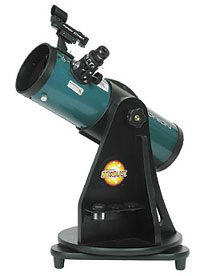
A small reflecting telescope.
Night Sky: Craig Michael Utter
Any telescope must have a sturdy, smoothly working support. Many scopes come with mounts, but others, especially small ones, are sold as optical tube assemblies only (called OTAs). If you buy one of these, you’ll need to supply your own mount. Luckily, smaller telescopes often come with a mounting block that allows them to be attached to a standard photo tripod with a single screw.
But beware: A tripod that’s good enough for taking family snapshots may be too wobbly for astronomy. As a very rough rule of thumb, a photo tripod will support its own weight nicely when used for astronomy. If the tripod weighs more than the scope, that’s better still — I even try for a weight ratio of 2:1 or more if possible. And while a common photo tripod might work well with smaller scopes, once the aperture hits 3 inches and larger, you'll probably need a specialty telescope mount to get enough steadiness. Here’s another consideration: the higher powers afforded by compound telescopes require even more steadiness and thus a sturdier mount — which may negate the size advantage of their compact tubes.
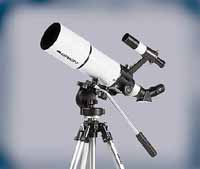
A small refractor on a tripod.
Sky & Telescope
Mounts designed for telescopes usually forgo the single-screw attachment in favor of larger, more robust rings or dovetail-attachment plates. On some mounts the scope swings left-right and up-down, just as on a photo tripod; these are altitude-azimuth (or simply altaz) mounts. A more involved mechanism, designed to track the motion of the stars by turning on a single axis, is the equatorial mount. But equatorial mounts tend to be larger, heavier, and more complicated, which may take them out of the running for travelscope consideration.
Finally, remember to leave room for your accessories: eyepieces, extra batteries, any tools needed, your star atlas and sky guidebook, notebook, pencils, and a dim red flashlight so you won’t ruin your night vision. Many manufacturers make custom cases for their telescopes, often with spaces for accessories.
When sorting through all these possibilities, remember that a small telescope that gets used often will show you more than a large one that gathers dust in the garage waiting for that perfect night when you have lots of time. This is especially true of a travelscope. A small, lightweight scope will tend to get used more. And the less setup you have to do, the better. Best of all is a telescope that can be packed and picked up in one piece with one hand.
Other Options
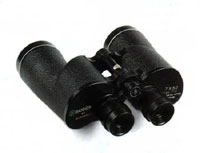
Binoculars have long held a prominent place in amateur astronomy, with many observers having them as part of their everyday observing kit. The best glasses for general astronomy are 7 x 50s or 10 x 50s. High optical quality is more important for astronomy that for daytime use. However, any binoculars can work as an astronomical instrument. What size you choose depends on your budget and portability needs.
SkyWatch: Chuck Baker
Not enough room for a telescope of any size? Binoculars are a great astronomy tool. For stargazing, you want binoculars with front lenses at least 30 mm across, preferably 50 mm. (How can you tell what you’ve got? Near the eyepieces you’ll find two numbers separated by "x". The first is the magnification; the second is the diameter of the front lenses in millimeters.) I consider 8x50 binoculars best for general-purpose viewing at night. But even modest 7x35s can show you bright, well-known trophies like the Andromeda Galaxy, the Orion Nebula, and the Pleiades cluster — often even out of a hotel window.
On the other hand, if you're planning on staying someplace for a while, forget about packing a scope and ship it instead! Most hotels will hold packages for you at the front desk. If you’re going to a remote location, try shipping to one of those packaging stores (like the "UPS Store"); these will generally receive and hold packages for a small fee, if any. This way you can ship a larger scope than you’d be able to carry on a plane and saves the hassle of dealing with large cartons at airports (and unpacking and explaining a strange metal tube to airport security). Be sure to save all the packaging that your scope arrives in — you’ll have a ready-made shipping container if the need arises.
Whether By Land or Air
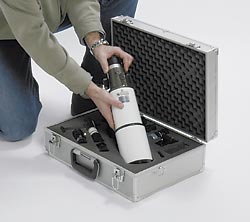
When packing your telescope for a road trip, make sure it's well protected from dirt and damage. Many manufacturers offer custom, foam-padded travel cases for their products. Don't forget your star charts and other accessories!
Night Sky: Craig Michael Utter
If you’ve already got a telescope, regardless of its size, by all means consider taking it along on your next road trip — especially if you’ll be camping or visiting a site with dark skies. My rule of thumb: if you can carry it, and if it’ll fit in the trunk, bring it! If you’re going by car, you’ll be tempted to wait until everything else is packed before seeing if the telescope will fit. Instead, try putting it (and its padding) in first and then fitting your luggage around it. This lets you take out your luggage first when you reach your destination — an important hassle-saver at the end of a day of driving.
If you’re flying, find out about your airline’s luggage restrictions in advance. Carryons are usually limited to one 22-by-14-by-9-inch bag and one other personal item, like a small knapsack or computer case. I used to sidestep these rules all the time, but those days are long gone. If your bag is too large, assume that you’ll have to check it — and you’ll want to think twice about checking any easy-to-damage item like a telescope. If you would feel uncomfortable throwing the package around, it doesn't belong in airline luggage.
And be aware of the weight limits. I was once charged a fee because one of my equipment cases was over the 50-pound-per-item maximum. Had I split the gear between two smaller cases, I would have escaped the fee! The moral? Call the airline beforehand to find what policies apply.
Finally, if you're taking a scope out of the country, make sure you either register it with Customs before leaving, or bring along receipts to prove that you bought the gear locally. You don't want to have to pay an import duty on something you didn't buy on the trip!
Small Scopes Deliver Big Views
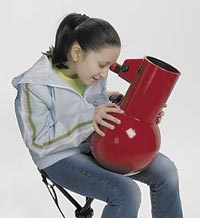
Night Sky: Craig Michael Utter
Next to "What kind of telescope should I buy?" I most often hear, "What can I see with it?" From your backyard or driveway, many small scopes with apertures between 70 and 114 millimeters ( 2.7 and 4.5 inches) can keep you busy star-gazing for a long time. More specifically, they’ll all show you
- hundreds of craters on the Moon
- Saturn’s rings (and perhaps a couple of its moons)
- Jupiter’s main cloud belts and its four big moons
- Mars as a tiny reddish disk (when it's near Earth)
- Venus going through phases (as the Moon does)
- sunspots (using a safe solar filter)
- colorful double and triple stars
- many variable stars
- the Orion and Lagoon nebulae and the Andromeda Galaxy
- dozens of other galaxies, nebulae, and star clusters.Some telescopes will yield sharper images than others, usually at higher cost. But all will do the job. And, when you’re at home, issues like portability become less important, so consider getting a larger, sturdier mount for use in the backyard. Refractors and compound telescopes can also provide excellent daytime views of terrestrial objects with the addition of an inexpensive erecting prism. Birders, take note!Remember: there is no one "perfect" telescope, so stop looking for it. Rather, evaluate your needs and budget, act accordingly, and then start packing.
 0
0
Comments
You must be logged in to post a comment.